Grass merger options grow as farmers seek rake alternative
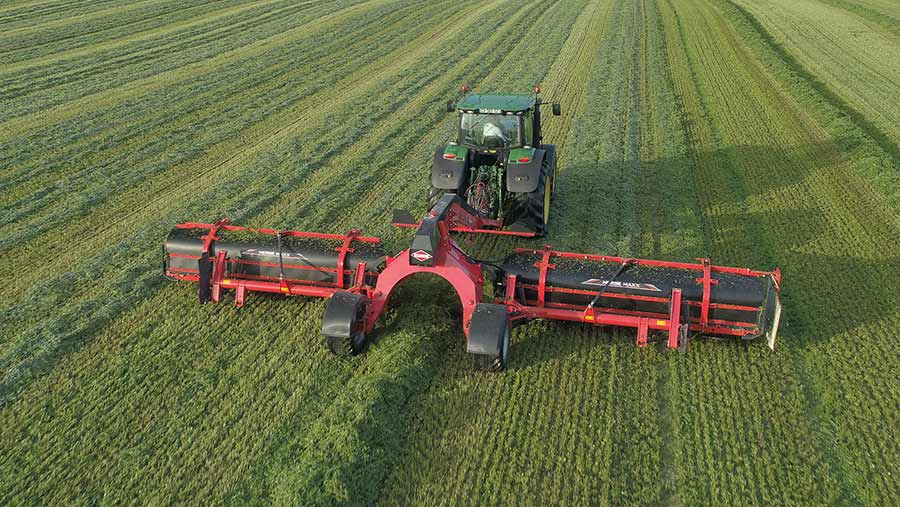 Kuhn Merge Maxx 950 in action © Kuhn
Kuhn Merge Maxx 950 in action © Kuhn With the promise of cleaner grass gathering and higher work rates, belt mergers are gaining favour for high-quality silage making. We delve into the details of the different machines available.
Kuhn
The four-model range of Merge Maxx implements from Kuhn provides numerous capacities and configurations.
Deploying two pick-up and merging belt units means the trailed models cover centre delivery working widths of 6.2-7.5m from the Merge Maxx 760; 8.2-9.5m with the 950 version costing £88,320; and 10.7-11m from the Merge Maxx 1090, which retails at £101,170.
They can also shift material to either side, both sides or to either side and centrally, with an optional curtain available to help side-delivery swath formation.
All three models have manually adjustable belt speed to match forward speed and the volume of crop.
On-board hydraulics powered by the tractor’s 750rpm or 1,000rpm pto drive the belts and cam-type five-row pick-up reels, which are assisted by a spring-loaded swath roller and wind guard assembly.

Merge Maxx 1090 in transport configuration showing the two fixed skids © Kuhn
Height adjustment via the two fixed skids on each pick-up section is by a pin-and-hole mechanism on the Merge Maxx 760 and by a crank providing continuous adjustment on the two larger machines.
In both work and transport configurations, the pick-up and conveyor assemblies are supported by coil springs on a two-wheel chassis.
The trailed mergers can be operated in combination with Kuhn’s 3m front-mounted 440F. This has a single pick-up reel, but two belts that can be driven in opposite directions to put an equal amount of grass in front of the trailed units.
Clearing a path ahead of the tractor in this way avoids running over the grass, Kuhn points out, which otherwise could necessitate setting the trailed unit’s reels closer to the ground to lift the tractor’s wheelings.
The front-mounted version can also be operated on its own with both belts delivering to left or right, in which case it covers an overall width – including the resulting swath – of approximately 4.4m.
Two rotating skids (adjustable to set the pick-up working height) support the 1.1t total weight to minimise surface damage over peaks and through turns, and hydraulic suspension is said to provide consistent ground pressure while allowing +/-10deg of pick-up movement to follow undulations.
See also: Buyers guide: Second-hand four-rotor rakes
Oxbo
Through its Ploeger UK operation in Fakenham, Norfolk, Dutch machinery manufacture Ploeger Machines currently offers two US-built trailed mergers from group sister company Oxbo International.
The trailed Oxbo 2334 and 2340 have three cam-type pick-up reels – a 3.1m assembly at the centre flanked by a pair of 3.66m units on the 2334 and two 4.27m units on the 2340, together with individual belt conveyors.
This arrangement means about 10m or 12m of spread or swathed grass is gathered and delivered either left or right by the 1m-deep belts, which are inclined by 5deg to the rear.
Each belt is driven by hydraulic motors at the ends, powered by an independent hydraulic system driven from the tractor’s 1,000rpm pto and comprising hitch-mounted gearbox and pumps, and 341-litre oil tank located at the back of the two-wheel, mechanically steered chassis.
In work, the pick-up and conveyor assemblies are supported on underside skids and a hydraulic suspension system with gas-filled accumulator “springs”.
For transport, the outer pick-up units fold back and upright, with 32kph the maximum recommended travel speed on the road.
Both Oxbo machines are supplied with a spare pto drive shaft and an autolube system, and throw-restrictor curtains are optional to help form a neat swath of light material.
Ploeger
For 2023, Ploeger Machines plans to introduce its own grass mergers, which are already on sale in other European countries.
The trailed CM2240 and self-propelled CM4240 models, each with two 5m pick-up and belt merging assemblies, are built in the company’s Netherlands factory using a pick-up design licensed from Austrian firm Reiter.
Both machines can gather grass from up to 11.8m into a single swath, with a choice of left, right or centre delivery; the latter produces a 0.8m- to 1.5m-wide swath, while side delivery produces swaths up to 2.5m wide.
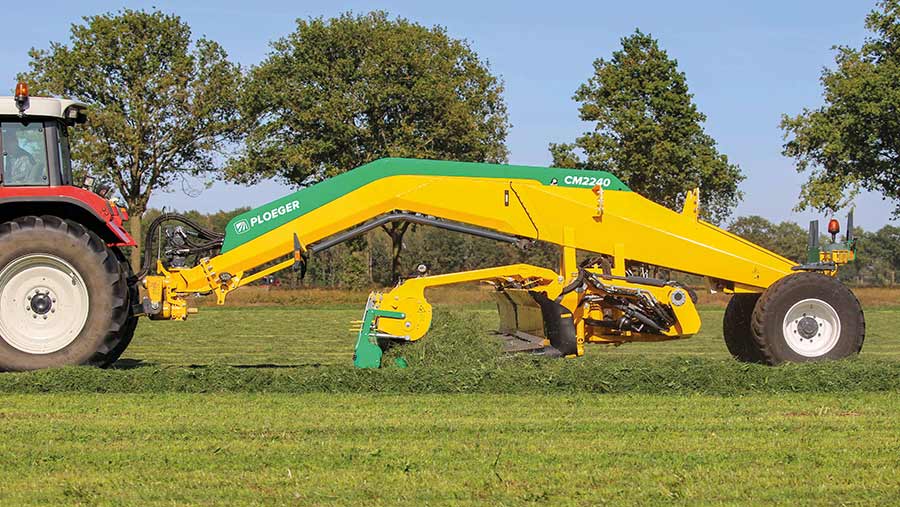
The Ploeger CM2240 trailed merger has a prominent ‘bridge’ chassis © Ploeger
Each of the flexible pick-up assemblies has two powered swath rollers, a small-diameter cam-less reel with trailing tines, and an overhead rotor with plastic tines in a helix formation to encourage even loading of the belt.
To match forward speed, the speed of these elements is adjustable on the go using a dedicated touchscreen display or an Isobus terminal.
A joystick is used to operate the lift-lower functions at headlands and to override the otherwise automatic tractor-tracking hydraulic steering on the two-wheel chassis for manoeuvring into corners.
Drive to the pick-up reel and conveyor assemblies is provided by a built-in hydraulic system with a pto gearbox and tandem pumps mounted on the machine’s lower linkage arms.
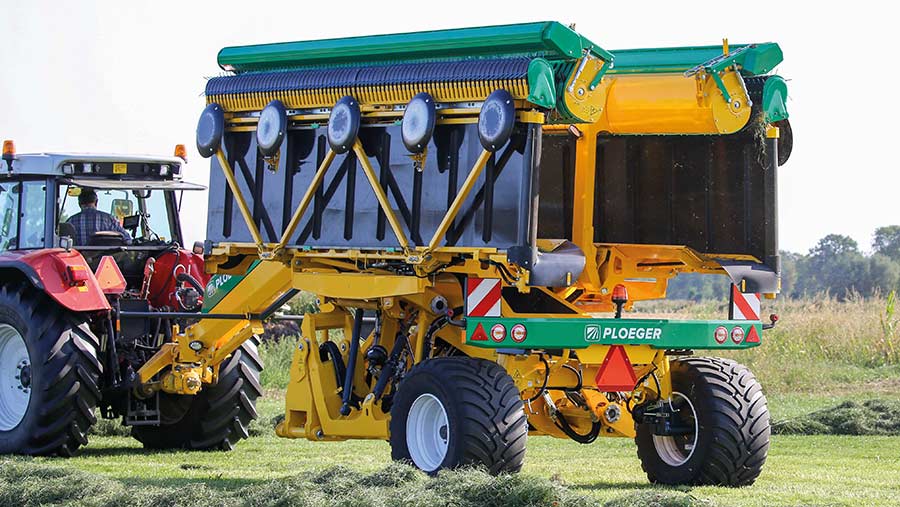
The Ploeger merger in transport configuration revealing the Reiter-licensed circular skids © Ploeger
Coil springs support the two decks in work as they ride on round skids that are free to rotate for minimal sward damage, and the decks fold back and upwards to a vertical position for transport.
Ploeger’s self-propelled model features a 260hp FPT engine and hydrostatic drive, and accommodates the operator in a Claas Vista cab with 7in touchscreen display and FleetCommand telematics.
Principle attractions of the self-propelled format, says Ploeger, are working speeds up to 20kph, a clear forward-looking view for the operator, and the lack of crop wheelings, which would otherwise require the pick-up reels to be set closer to the field surface.
Pottinger
A single trailed model with flexible swath-placement configurations marks Pottinger’s entry into the merger market for 2023.
The Mergento VT 9220 has two pick-up and conveyor assemblies, each mounted on a hydraulically cranked gullwing arm by a central pivot arrangement that allows the deck to adapt to ground contours in all directions.
Three hydraulic cylinders are part of this mechanism designed to provide even ground pressure and quick response to changes in the surface.
To maintain a consistent pick-up tine height, each deck runs on two crank-adjusted steel rollers supplemented by a fixed outer skid for extreme situations.
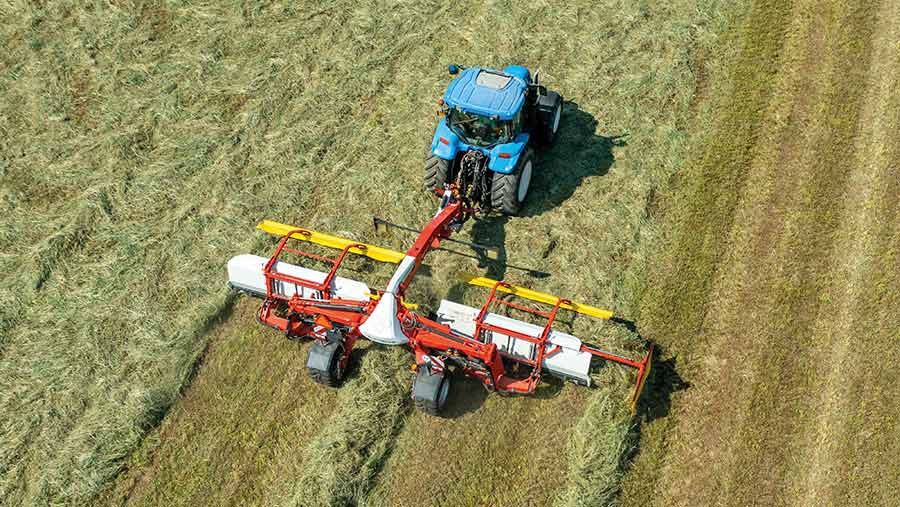
The Pottinger Mergento VT9220 delivering central and side swaths © Pottinger
In centre-swath mode, these decks are free to move vertically by 475mm upwards and 195mm downwards, with +30 to -13deg of lateral float. Fore-aft movement of +11.5deg is also available.
To ease the operator’s workload, the hydraulically driven pick-up reels and belts automatically stop and start again with an adjustable delay when lifted and lowered for a headland turn, and this feature also means there is no need to wait for the 900mm belts to empty before manoeuvring.
Hydraulic power for the reel and belt motors is provided by a triple-element pump mounted directly on the pivoting hitch, so the pto shaft universal joints always run straight.
It also allows the two belts and the pick-up reels to be regulated for speed and belt direction individually, and 160 litres of oil fills much of the main frame of the machine.
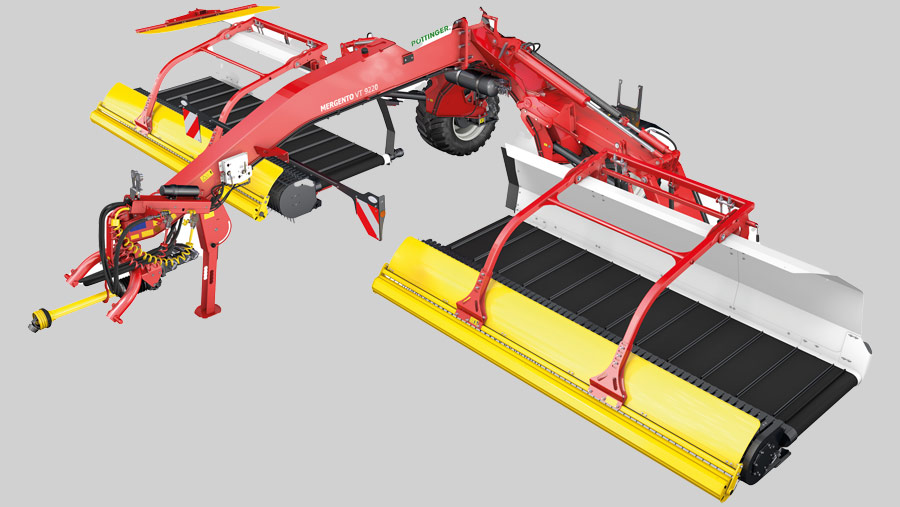
Each of the Mergento’s two decks is carried on a crank arm, with a central pivot allowing ground contour float in all directions © Pottinger
Altering the gap between the two decks by adjusting the support arm angle enables the Mergento VT 9220 to gather up to 9.2m of grass into one swath at the centre, or one to the centre and one to either side.
Alternatively, up to 8.7m of grass can be collected into a single swath delivered left or right, or two swaths placed to the left and right of the machine. An optional swath curtain is available, too.
The pick-up reel on each deck features six rows of cam-regulated tines working in conjunction with a freely rotating crop press roller and a wind guard, both mounted on two spring-loaded arms with a gas-filled damper discouraging abrupt movements.
The tines remain fully exposed until dipping down vertically just in front of the belt, which is set 120mm below the top of the reel to help the feed-on performance, especially when working downhill.
For transport between fields, the two decks fold vertically and are then settled into the lowest position with a hydraulic interlock engaged for stable travel with an overall height of 3.95m on the two-wheel chassis.
Added ground clearance can be dialled up by adjusting the decks upwards when passing through a field entrance.
A dedicated controller or Isobus terminal operates the Mergento’s various functions, with Aux-N functionality allowing some to be allocated to tractor buttons and joysticks. In both cases, it includes a service indicator and notification, as well as an hour and area counter.
The new machine is priced £89,489, with a hydraulically adjustable swath curtain adding £2,190.
Reiter
Key patented features of the Respiro forage mergers from Austrian manufacturer Reiter include a flexible pick-up designed to hug ground contours, which works in combination with circular skids that are free to rotate and so minimise surface damage as they skim over peaks.
Together with the small diameter of the reel, trailing tines with a cam-free action, and an overhead rotor made up of plastic tines arranged in a spiral pattern, the company says the Respiro is designed to gather up forage cleanly and form it into neat swaths.
The range kicks off with the front-mounted 3m Respiro R3 compact with a choice of 700mm or 1,000mm belts, and the 3.5m version with a 1,000mm belt, delivering swaths to either side.
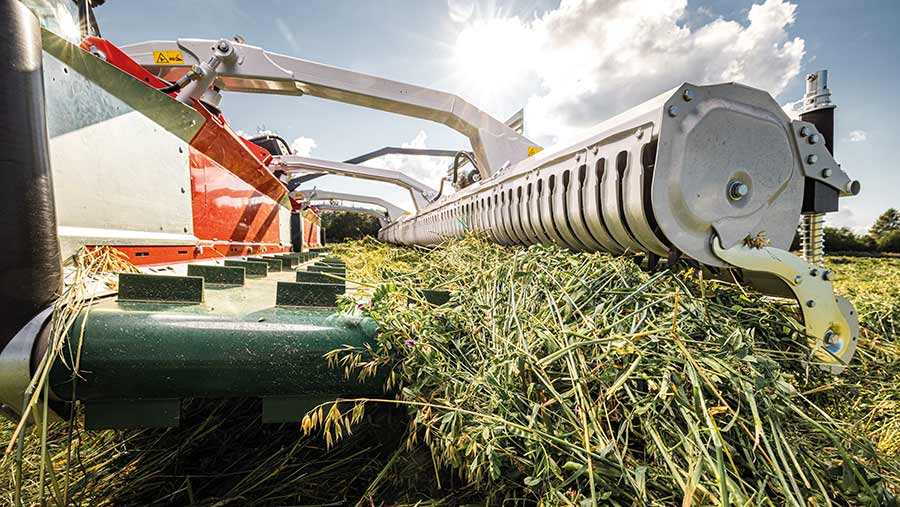
A small-diameter pick-up with a feed rotor above is a notable feature of all Reiter mergers © Reiter
These models are built to keep weight as close to the tractor as possible and a pivot arrangement allows +/-15deg of lateral movement over contours, in addition to the capabilities of the flexible pick-up reel, while coil springs provide adjustable float characteristics.
The Profi version of these models comes with its own coil suspension and a geometry similar to that seen on more sophisticated front-mounted mowers.
It is designed for faster reaction and a lighter float over undulations to allow quicker working speeds and greater outputs.
Using a reverse-drive tractor to eliminate the crop wheelings is catered for by the 6m (plus swath width) R6 RD with 700mm or 1,000mm belts, and the 7m R7 RD with the wider belt only.
They both have two separate pick-up and conveyor assemblies that deliver swaths wholly to the left or right, or simultaneously to right and left in heavy crops. These rotate to a vertical position for travel between field and yard.
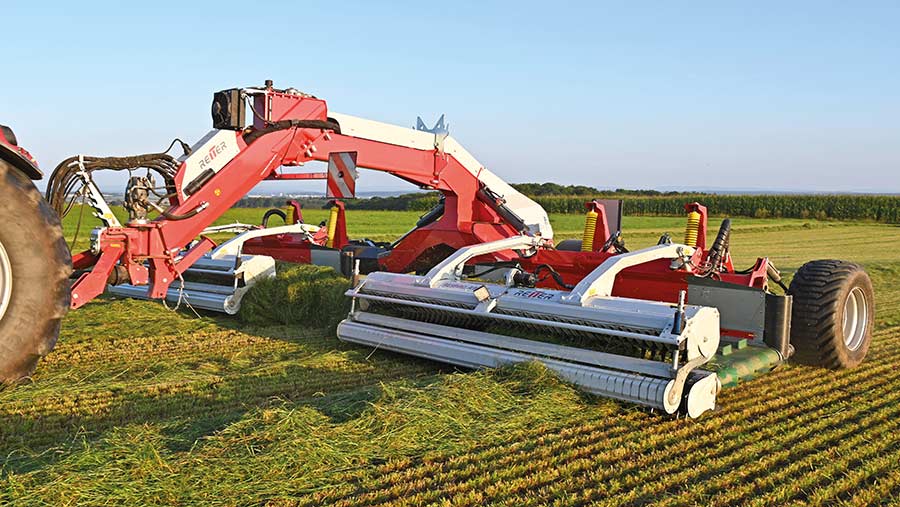
Respiro R9 profi is Reiter’s trailed merger; the maker also produces front-mounted and reverse drive tractor versions © Reiter
For trailed operation, Reiter produces the Respiro R9 Profi, a twin-deck machine with a working width of 8-9m when forming a central 1-2m swath, or 7m (plus the swath size) when the two 1,000mm belts deliver wholly to the left or right.
The two decks are carried on a centre-split folding frame that brings them to a vertical position, secured by two hook locks for transport.
In the working position, each deck is carried on two lower linkage arms and a hydraulic top link, with coil suspension. However, unlike other trailed machines, the R9 Profi has a four-wheel chassis – two wheels on the centre frame, one each on the wing sections – for added deck height control and to prevent them rocking through headland turns.
Drive to the pick-up and belt elements is by tractor pto through a 90deg gearbox to a pair of axial piston pumps mounted above the hitch pivot.
Using this type of pump means flow rate can be varied to alter pick-up and belt speeds while maintaining a constant pto speed.
For example, the reels can be set to run at 100-120rpm for delicate leafy crops or up to 200rpm for more robust forage to increase output.
In addition to manual flow rate adjustment through the hand-held controller or an Isobus terminal, there is an auto mode that maintains a consistent relationship between pick-up, rotor and belt speeds and the working speed of the machine – handy in steep fields and very variable crops.
Auto stop-start for the belts when lifting and lowering the decks for headland turns is also part of the package, to reduce the operator’s workload and save having to wait for the belts to empty before turning.
Features common to all Reiter Respiro forage mergers include the flexible pick-up reel supported at each end and in the middle by round skids that rotate when passing over surface peaks to minimise scarring.
The tines operate with a trailing motion at all times to minimise the risk of picking up stones and other debris, and each group of six twin tines is secured in a moulding by a steel band and single bolt so that the coil will be retained should one or more break.
Continuous forage flow is encouraged by a freely rotating crop roller ahead of the reel and a driven contra-rotating feed rotor above it to ensure positive transfer to the belt. Both are mounted on hydraulically supported arms that respond to variable amounts of incoming forage or lumpy swaths.
Distribution arrangements for Britain are being finalised.
ROC
Italian company ROC is one of the longest-established manufacturers of pick-up belt mergers and has the largest range, with trailed two-deck models from 4.9m to more than 12m wide, and mounted versions for regular and reverse-drive tractors and self-propelled mowers.
Kverneland now distributes the machines here, with parent company Kubota having acquired majority ownership, and there are currently three models available in Britain – the RT 380 front-mounted unit at £27,710; and the trailed RT 730 (£99,520) and RT 880 (£112,744).
The 2.95m-wide RT 380 has an effective working width of about 3.8m when the swath delivered to either left or right is included, and its 890kg mass is carried on a three-point linkage with a chain and hydraulic cylinder stabilising mechanism.
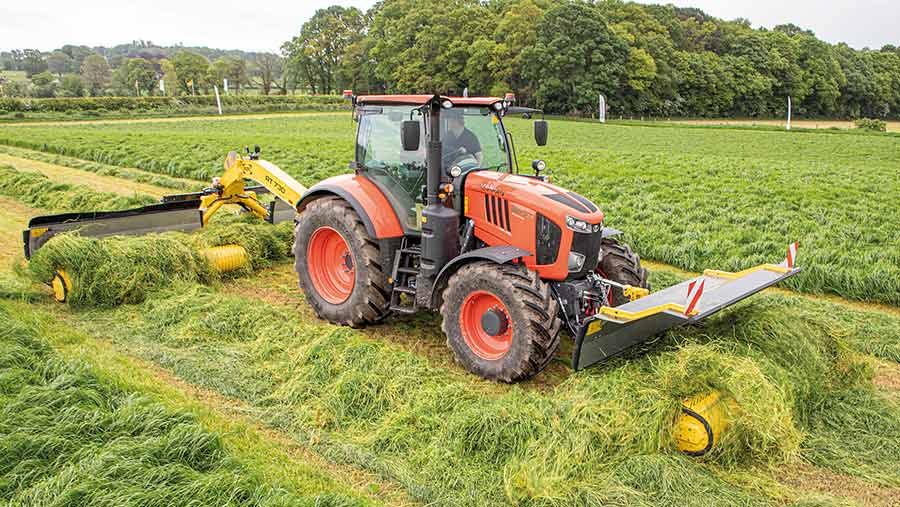
A front-mounted ROC RT 380 and trailed RT 730 working in combination © ROC
Hydraulic drive to the camtrack-controlled tine reel and lateral belt is also supplied by the tractor.
Operating this model alone or in conjunction with a trailed unit removes spread forage from the path of the tractor and avoids having to take into account any wheelings when setting the pick-up reel height.
The trailed models are twin deck machines, with each attached by a central pivot to a hydraulically adjustable cranked arm mounted on a two-wheel chassis that incorporates a hydraulic suspension system.
This arrangement allows the pick-up units to pivot laterally to compensate for surface contours in work, and for each assembly to fold into a vertical position for transport.
The decks of the RT 730 can be operated side by side to deliver a single swath to left or right, or one swath each to both sides from a gathering width of 6m.
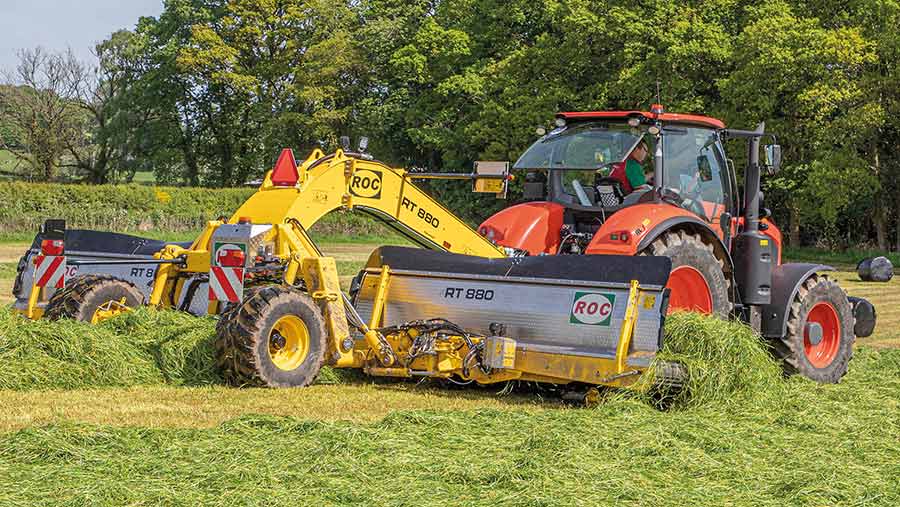
Twin decks are in a fixed position on the ROC RT 880 to deliver one central swath, or one central and one side swath © ROC
Alternatively, they can be moved apart by adjusting the crank arms to span up to 7.3m and produce a single swath of adjustable width at the centre, or one at the centre and one to right or left.
On the RT 880, the decks are permanently separated to gather forage in an 8.85m pass into a 1.5m central swath or lay one centre and one side swath.
In work, each deck is supported by four small rollers mounted in pairs on a spring-loaded staggered rocking beam axle to traverse the ground from just behind the pick-up reel to more than halfway across the belt to help maintain a consistent tine height.
The reels and belts are powered directly by hydraulic motors, with automatic belt drive interruption and restart an option when lifting and lowering the decks through a headland turn to reduce operator workload.
A conventional switch box controls all functions and an automatic lubrication system is optional.
SIP
A trailed merger that can be operated offset from the tractor is a unique configuration from Slovenian maker SIP.
The single-deck Air 500 T – priced £77,750 with brakes and side curtain – has a pick-up width of 5m and delivers a single swath to either side.
Its telescopic overhead drawbar enables the merger to operate to the left or right of the tractor, as well as inline, to provide additional options for gathering spread forage into a swath or to combine existing swaths.
For yard-to-field transport, the deck is rotated to a longitudinal position and brought in line behind the tractor.
Operating this machine with the Air 300 F front-mounted model, which comes with a swath curtain for £27,021, increases the overall grass-gathering width to 8m and eliminates running over spread grass.
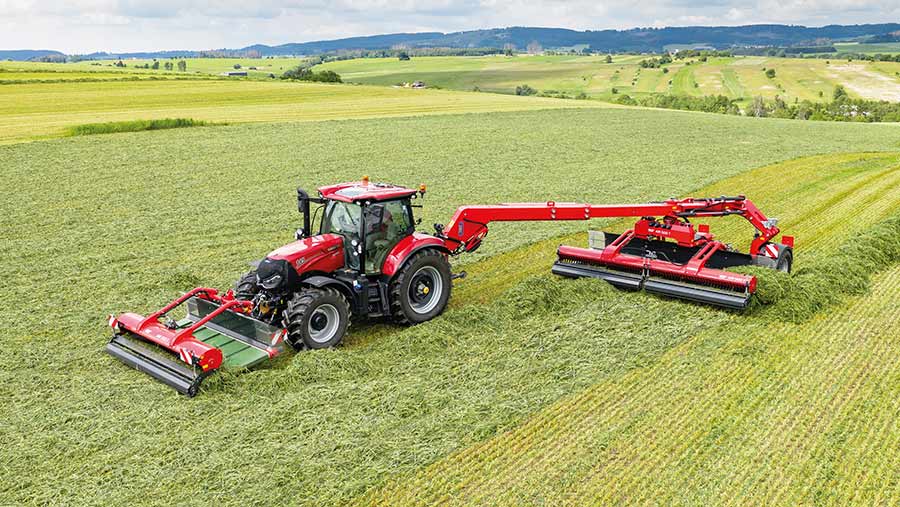
The Air 300 F and offset Air 500 T from SIP © SIP
SIP’s wider Air 900 T – which is listed at about £98,000 to full spec with swath curtain, work lights and air brakes – is a more conventional partner for the front-mounted model, being a solely inline machine.
This one is capable of drawing 9m of forage into a central swath or 7m-worth when forming a side swath to either the left or right.
Each deck is mounted on a linkage incorporating hydraulic suspension designed to minimise weight on the skids. This assembly is mounted on a lateral arm that includes a hydraulic sliding mechanism to position the decks together or apart.
The two arms pivot from the backbone main frame to raise the decks to a vertical position for transport, resulting in a relatively short overall length.
Common to all three SIP Air mergers is the Reiter flexible pick-up reel, overhead feed rotor and belt conveyor technology that SIP licenses, which includes circular underside skids that are free to rotate, and a small-diameter reel with trailing cam-free tines.
And on both trailed units there is an integrated hydraulics package for the reel, rotor and conveying belt-drive motors that includes two variable-output pumps mounted in tandem on the hitch, with pto drive from the tractor via a gearbox.

